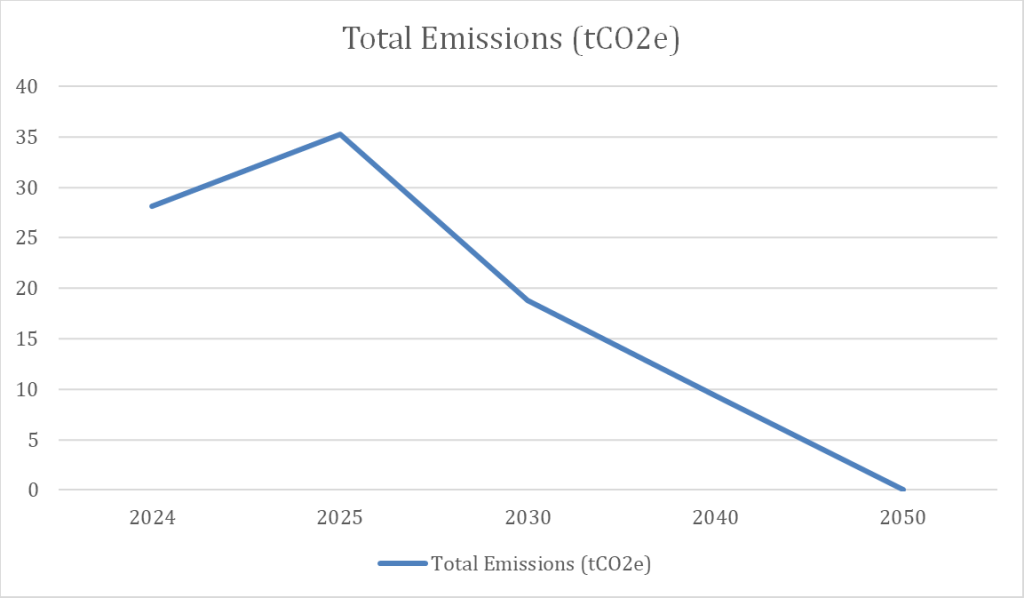Commitment to Achieving Net Zero
Diegesis is committed to achieving Net Zero emissions by 2050.
Baseline Emissions Footprint
Baseline Year: 2024
Additional Details relating to the Baseline Emissions calculations:
As a small business operating from a shared office space, we do not have direct access to utility usage data. Our emissions have been estimated based on employee numbers and standard government benchmarks for electricity use and commuting patterns. This is our first carbon footprint assessment, so 2024 serves as our baseline year.
Baseline Year Emissions (2024):
| EMISSIONS | TOTAL (tCO₂e) |
| Scope 1 (direct) | 0 |
| Scope 2 (electricity) | 14.65 |
| Scope 3 (commuting + travel) | 13.44 |
| Total Emissions | 28.09 |
Current Emissions Reporting
Reporting Year: 2025
| EMISSIONS | TOTAL (tCO₂e) |
| Scope 1 (direct) | 0 |
| Scope 2 (electricity) | 19.33 |
| Scope 3 (commuting + travel) | 15.89 |
| Total Emissions | 35.22 |
Emissions Reduction Targets
In order to continue our progress toward achieving Net Zero, we have adopted the following carbon reduction targets:
We project that carbon emissions will decrease over the next five years to 18.75 tCO₂e by 2030, a reduction of approximately 33% from our 2024 baseline.
Carbon Reduction Projects
Completed Carbon Reduction Initiatives
-
- Introduced a 3-day in office requirement model, reducing office commuting days.
-
- Prioritised public transport usage, with 95% of staff commuting via bus/train.
-
- Adopted green electricity initiatives, such as motion sensor lighting and smart water taps.
-
- Implemented energy-saving policies in the workplace.
These measures helped contain our emissions despite headcount growth.
Future Carbon Reduction Initiatives
-
- Encourage low-emission commuting (e.g., promoting our Cycle to Work Scheme).
-
- Review procurement policy to prefer low-carbon suppliers.
-
- Work with our building management to improve energy efficiency and monitor shared utility use.
-
- Invest in staff awareness and training around sustainability best practices.
Supporting Explanation of Emissions Estimates
Due to shared rented office space, direct measurement of energy use is unavailable. We estimated emissions based on average electricity use per employee (1,292 kWh/year) and government emission factors for electricity consumption.
Our hybrid model involves staff working onsite 3 days per week on average, with 95% commuting by public transport and 5% by car. We estimated commuting emissions accordingly:
Electricity (Scope 2):
2024: 55 employees × 1,292 kWh × 0.206 kgCO₂e/kWh = 14.65 tCO₂e
2025: 65 employees × 1,292 kWh × 0.23 kgCO₂e/kWh = 19.33 tCO₂e
Commuting and Business Travel (Scope 3):
Commuting emissions per employee = ~0.194 tCO₂e/year based on travel distances and mode splits.
Business travel assumed at 0.05 tCO₂e per employee annually.
Total Scope 3 emissions:
2024: (55 × 0.194) + (55 × 0.05) = 13.44 tCO₂e
2025: (65 × 0.194) + (65 × 0.05) = 15.89 tCO₂e
Progress Chart

*Note: Will be updated as more data becomes available.
Declaration
This Carbon Reduction Plan has been completed in accordance with PPN 06/21 and associated guidance.
Emissions have been reported and recorded in accordance with the GHG Reporting Protocol corporate standard and the appropriate UK Government conversion factors.
Scope 1 and Scope 2 emissions have been reported in accordance with SECR requirements, and the required subset of Scope 3 emissions has been reported per the Corporate Value Chain (Scope 3) Standard.
